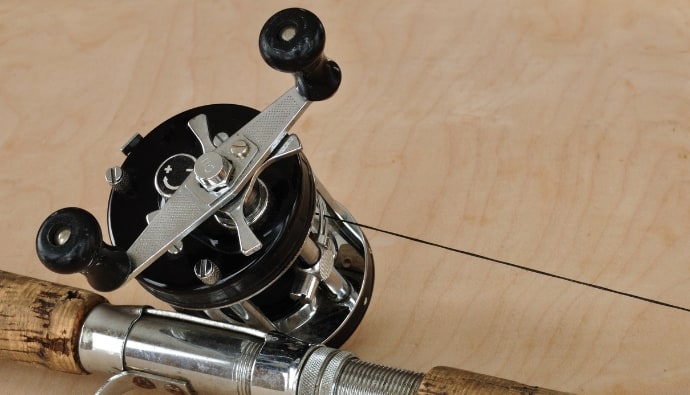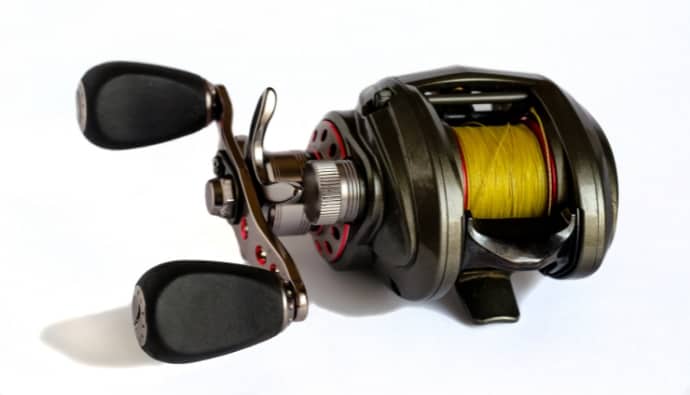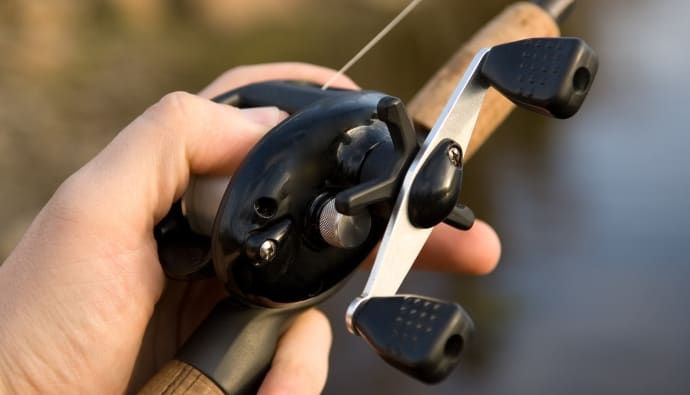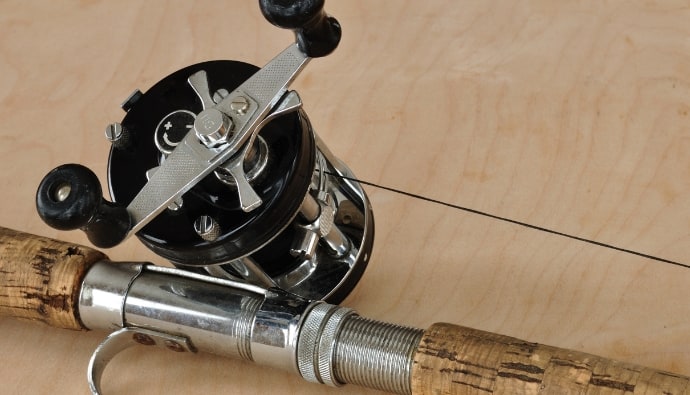In this guide, we’ll show you how to spool a conventional reel. Doing it yourself will save time and money and give you a better sense of your gear.
You don’t need specialized or expensive spooling tools to do this. Here are some simple methods and tips that can help you in spooling these reels.

Step-By-Step for How to Spool a Conventional Reel
Bucket Method
For this reel spooling process, you will need a pair of thick gloves, a five-gallon bucket with two gallons of water in it, and the reel you want to spool.
Step 1
If you’re using loading mono, then tie an arbor knot or equivalent to your spool and snip the tag end leaving around an inch.
Step 2
Take your spool and drop it in the bucket of water.
Step 3
Hold your gloved hand along the rod, making sure your thumb and index finger are pinching the line snugly.
Step 4
Put tension on the line as you reel using your other hand. Make sure you move your hand, applying pressure from side to side to lay the line down evenly.
Tips
Make your life easier by putting the fishing rod in a holder. That way, instead of taking hold of the rod and placing pressure on it, you can guide the line using your gloved hands only. With this trick, you can also ensure the line remains tight on the spool during and after you are done winding it.
If you don’t have a fishing bucket you can also put a rod through the spool and have it freespin. This can also be done with a buddy by having them take hold of the line and let the spool rotate with a little pressure to add tension.

Backfill vs. Topshot
Experienced anglers rely on several methods when they aim to catch big fish, and the main rule they follow is to use a reel that has enough line capacity for the giant species they are targeting.
This is important since it prevents spooling in case the boat is adrift or the captain of the ship is a bit slow in catching up with the fish. A top shot setup proves invaluable when you have a smaller reel for straight monofilament and want an extra line with braid but still keep the benefits of mono near the lure or bait.
You can use this method to spool with a super braid line before topping it off (top shot) with 5 to 300 yards of the mono fishing line, depending on your situation. The main benefit you will get from this is that since the former has a smaller diameter compared to the latter, you can pack in more reel on the spool without compromising its breaking strength.
Mono is great for abrasion resistance and stretches which allows fewer hook pulls.
Braid vs. Mono Fishing line
Mono fishing line is more flexible and thinner in comparison to braid, which makes it gentler on the hands as well. It’s light enough to float on water, which makes it ideal if you want to use topwater lures.
Braid is great if you need a thinner diameter and less stretch. They tend to be less ideal if you’re fishing around the structure, as a knick in the line would cause it to break.
If you’re going to spool your reel with braid, here are two options for making it easier:
- Option 1 – Start with a mono fishing line and create a layer of it around the base of the spool before tying on your braid and filling it up or adding a certain amount and finishing off with a top shot.
- Option 2 – Stick a layer of masking tape around the bare spool of the reel. This will give the braided line more friction when you are spooling it. Some people don’t like this method as it can harbor water along the spool for a long period of time.
Make sure that you pack the braid tight when you are spooling it. It is thinner in comparison to a mono line and will dig in itself otherwise. If it succeeds in digging into the layers, your casting performance will take a hit, and you can fish without generating annoying knots.
Additionally, also make sure that you maintain tension on this line when you are spooling it. That way, it will remain consistent throughout without creating unwanted knots.
Frequently Asked Questions
It’s best to look at your reel for manufacturer recommendations. Generally, it’s best to stop filling a little bit before full.
If you’re new to conventional reels, start by simply dropping your bait down while keeping your thumb on the spool. Over time you’ll want to tighten the drag and practice light undercasts with your thumb on the spool to prevent bird nests. Over time you’ll get more comfortable casting further.
Yes, you can use braid on a multiplier reel. Always follow the manufacturer’s recommendations or talk with your local tackle shop. Braid might not be ideal for the fish you’re targeting.
Yes, especially if you are using mono. Leave it to soak in a bucket of water for a while beforehand. This will saturate the line, and it will bend adequately when you are wrapping it without the need for additional pressure. Coach also likes to add a bit of soap to the water to reduce the friction a bit too.




 Facebook
Facebook YouTube
YouTube








